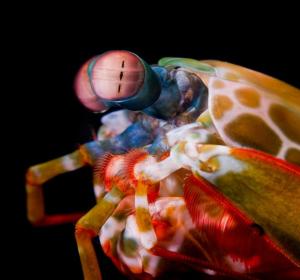Ever notice how strange the Mantis Shrimps eyes are? Things just recently got a bit more strange for these little guys. A new study conducted by Michael Bok at the University of Maryland
indicates that mantis shrimp use amino acids that are normally found as a
natural sunscreen in animal skin in order to see UV light.
Mantis shrimp who are known by some aquarists to crack aquarium glass with their mighty claw are also now set up with an impressive visual system. Ultra violet light, which is not on the wavelength scale that the human eye can see, these crabs can see the orientation or polarizations of light waves.
Mantis shrimp have filters within their
eyes that absorb UV light. Bok discovered that these filters are made
out of mycosporine-like amino acids (MAAs), which typically absorb
harmful ultraviolet light in animal skin. The MAAs in mantis shrimp eyes
instead absorb different parts of light, allowing them to discern UV
light.
“The overall construction of the mantis
shrimp's visual system is just so unbelievably ridiculous, so this is
just another piece of that tapestry,” said Bok. “It's a very, very
strange system, and it’s very alien compared to ours.”
Mantis
shrimp are complicated creatures. They are fierce hunters, killing prey
with swift blows from their powerful claws, which can accelerate as fast as a .22-caliber bullet. Some species are monogamous, but all exhibit complex social behavior.
Mantis shrimp vision seems
to be a crucial ingredient to the animals' success. Mantis shrimp have
12 photoreceptors, compared with three in humans, and they see more
wavelengths of light than humans do.
Weirdly, though, mantis shrimp don't seem to discriminate between colors
with as much sensitivity as humans; a study published in January in the
journal Science found that their impressive 12-photoreceptor array
allows them to process color in the eye instead of in the brain. (In
contrast, humans have a fairly simple eye, but lots of visual processing
set up in the brain that helps us to see thousands of shades.)
"You can envision it as them 'coloring in the world,'" Bok said.
It was these specialized
cells that interested Bok and his colleagues. They knew that five or six
of a mantis shrimp's photoreceptors were used for seeing ultraviolet light,
and they wanted to identify the visual pigments that made up these
receptors. An initial molecular analysis of the eye of the species Neogonodactylus oerstedii, however, turned up only two pigments.
That
was a bit of a surprise, Bok said. The researchers figured the mantis
shrimp eye must have filters to "sort" wavelengths before they hit the
visual pigments, but the scientists didn't know where to look, at first.
Because UV wavelengths are invisible to humans, there would be no way
to see the UV filters with the naked eye.
Fortunately,
the researchers discovered that as the filters in mantis shrimp eyes
absorb UV light, they emit a tiny bit of fluorescence, visible to
humans.
The filters are made of something called MAAs, or mycosporine-like amino acids. These amino acids are common in the skin of marine organisms, and are usually used to absorb cell-damaging UV light.
Mantis
shrimp, however, have repurposed the MAAs to absorb certain UV
wavelengths in the eye. Each different filter removes different portions
of the light, meaning that certain wavelengths only hit certain areas
of the eye.
"It pretty nicely
narrows their sensitivity by removing certain components of the
spectrum," Bok said. The filtering thus enables the mantis shrimp to
detect multiple wavelengths with only two visual pigments.
Bok,
who is currently doing fieldwork on the Great Barrier Reef in
Australia, said the next goal is to study how mantis shrimp use their
unusual visual system. They might use visual information to communicate,
to hunt or to avoid predators, he said.
Bok and his colleagues reported their findings July 3 2014 in the journal Current Biology.
Original article on Live Science.



No comments:
Post a Comment
Comments.....